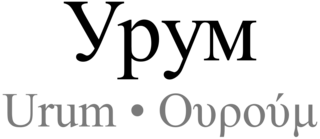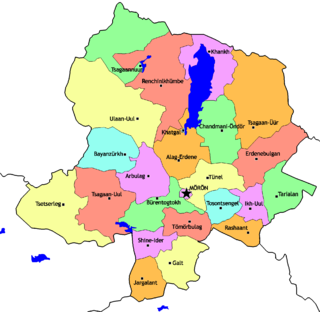
Altaic is a controversial proposed language family that would include the Turkic, Mongolic and Tungusic language families and possibly also the Japonic and Koreanic languages. The hypothetical language family has long been rejected by most comparative linguists, although it continues to be supported by a small but stable scholarly minority. Speakers of the constituent languages are currently scattered over most of Asia north of 35° N and in some eastern parts of Europe, extending in longitude from the Balkan Peninsula to Japan. The group is named after the Altai mountain range in the center of Asia.

The Turkic languages are a language family of more than 35 documented languages, spoken by the Turkic peoples of Eurasia from Eastern Europe and Southern Europe to Central Asia, East Asia, North Asia (Siberia), and West Asia. The Turkic languages originated in a region of East Asia spanning from Mongolia to Northwest China, where Proto-Turkic is thought to have been spoken, from where they expanded to Central Asia and farther west during the first millennium. They are characterized as a dialect continuum.

The Yugurs, Yughurs, Yugu, traditionally known as Yellow Uyghurs, are a Turkic-Mongolic ethnic group and one of China's 56 officially recognized ethnic groups, consisting of 16,719 persons, according to the 2000 census. The Yugur live primarily in Sunan Yugur Autonomous County in Gansu. They are mostly Tibetan Buddhists. The majority of Yugurs speak a Turkic language, while Mongolic and Chinese are also used in eastern provinces.

The Chuvash people, plural: чӑвашсем, çăvaşsem; Russian: чува́ши ) are a Turkic ethnic group, a branch of the Ogurs, native to an area stretching from the Idel-Ural (Volga-Ural) region to Siberia.
Bulgar is an extinct Oghuric Turkic language spoken by the Bulgars.
Chuvash is a Turkic language spoken in European Russia, primarily in the Chuvash Republic and adjacent areas. It is the only surviving member of the Oghur branch of Turkic languages, one of the two principal branches of the Turkic family.

Qashqai is an Oghuz Turkic language spoken by the Qashqai people, an ethnic group living mainly in the Fars Province of Southern Iran. Encyclopædia Iranica regards Qashqai as an independent third group of dialects within the Southwestern Turkic language group. It is known to speakers as Turki. Estimates of the number of Qashqai speakers vary. Ethnologue gave a figure of 1.0 million in 2021.

Urum is a Turkic language spoken by several thousand ethnic Greeks who inhabit a few villages in southeastern Ukraine. Over the past few generations, there has been a deviation from teaching children Urum to the more common languages of the region, leaving a fairly limited number of new speakers. The Urum language is often considered a variant of Crimean Tatar.

Khalaj is a Turkic language spoken in Iran. Although it contains many old Turkic elements, it has become widely Persianized. Khalaj has about 150 words of uncertain origin.

Khakas, also known as Xakas, is a Turkic language spoken by the Khakas, who mainly live in the southwestern Siberian Republic of Khakassia, in Russia. The Khakas number 73,000, of whom 42,000 speak the Khakas language. Most Khakas speakers are bilingual in Russian.

Salar is a Turkic language spoken by the Salar people, who mainly live in the provinces of Qinghai and Gansu in China; some also live in Ili, Xinjiang. It is a primary branch and an eastern outlier of the Oghuz branch of Turkic, the other Oghuz languages being spoken mostly in Western and Central Asia. The Salar number about 105,000 people, about 70,000 (2002) speak the Salar language; under 20,000 are monolinguals.

Khorasani Turkic or Khorasani Turkish is an Oghuz Turkic language spoken in the North Khorasan Province and the Razavi Khorasan Province in Iran. Nearly all Khorasani Turkic speakers are also bilingual in Persian.
The Kipchak languages are a sub-branch of the Turkic language family spoken by approximately 30 million people in much of Central Asia and Eastern Europe, spanning from Ukraine to China. Some of the most widely spoken languages in this group are Kazakh, Kyrgyz, and Tatar.
Proto-Turkic is the linguistic reconstruction of the common ancestor of the Turkic languages that was spoken by the Proto-Turks before their divergence into the various Turkic peoples. Proto-Turkic separated into Oghur (western) and Common Turkic (eastern) branches. Candidates for the proto-Turkic homeland range from western Central Asia to Manchuria, with most scholars agreeing that it lay in the eastern part of the Central Asian steppe, while one author has postulated that Proto-Turkic originated 2,500 years ago in East Asia.

The Siberian Turkic or Northeastern Common Turkic languages, are a sub-branch of the Turkic language family. The following table is based upon the classification scheme presented by Lars Johanson (1998). All languages of the branch combined have approximately 750,000–1 million native and second language speakers, with most widely spoken members being Yakut, Tuvan and Northern Altai. Despite their usual English name, two major Turkic languages spoken in Siberia, Siberian Tatar and Southern Altai, are not classified as Siberian Turkic, but are rather part of the Kipchak subgroup.

There is considerable dialectal variation in Turkish.

Dukha or Dukhan is an endangered Turkic variety spoken by approximately five hundred people of the Dukhan people in the Tsagaan-Nuur county of Khövsgöl Province in northern Mongolia. Dukhan belongs to the Taiga subgroup of Sayan Turkic. This language is nearly extinct and is only spoken as a second language. The ISO 639-3 proposal (request) code was dkh, but this proposal was rejected.
A. Sumru Özsoy is a leading linguist and Turkish academic working at Boğaziçi University, Istanbul.
Lars Johanson is a Swedish Turcologist and linguist, an emeritus professor at the University of Mainz, and docent at the Department of Linguistics and Philology, University of Uppsala, Sweden.

The Oghuz languages are a sub-branch of the Turkic language family, spoken by approximately 108 million people. The three languages with the largest number of speakers are Turkish, Azerbaijani and Turkmen, which, combined, account for more than 95% of speakers of this sub-branch.













